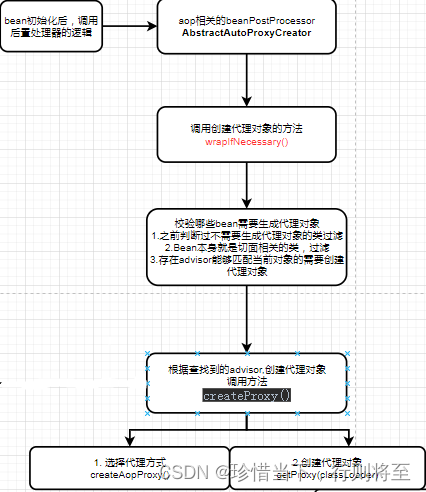简述:面向切面编程AOP在不改变原代码基础上,新增加代理增强类来达到要求。代理的方式分为静态代理、动态代理,静态代理在编译期将增强逻辑织入,而动态代理在运行期间新生成一个代理类,运行时执行代理类的方法。spring 中AOP封装了jdk和cglib的动态代理,本文主要介绍代理类生成及代理类方法执行的源码,具体了解其过程原理。
源码分析
1.代理类生成过程
回顾下spring bean的生命周期:合并definition->实例化前->实例化->实例化后->属性填充->执行aware的回调->初始化前->初始化->初始化后
代理类是在初始化后这个阶段由bean的后置处理器生成,因此可以从AbstractAutoProxyCreator后置处理器被调用的方法postProcessAfterInitialization()入手。
//初始化后调用beanPostProcessor的方法
public Object postProcessAfterInitialization(Object bean, String beanName) throws BeansException {
if (bean != null) {
Object cacheKey = getCacheKey(bean.getClass(), beanName);
//没有提前生成代理类
if (!this.earlyProxyReferences.contains(cacheKey)) {
//生成代理类并返回
return wrapIfNecessary(bean, beanName, cacheKey);
}
}
return bean;
}
生成代理类的方法
protected Object wrapIfNecessary(Object bean, String beanName, Object cacheKey) {
if (beanName != null && this.targetSourcedBeans.contains(beanName)) {
return bean;
}
//判断过不需要生成代理类的对象
if (Boolean.FALSE.equals(this.advisedBeans.get(cacheKey))) {
return bean;
}
//Advisor、Advice等类本身不需要AOP
if (isInfrastructureClass(bean.getClass()) || shouldSkip(bean.getClass(), beanName)) {
this.advisedBeans.put(cacheKey, Boolean.FALSE);
return bean;
}
// Create proxy if we have advice.
//查找匹配当前bean生成proxy拦截器方法
Object[] specificInterceptors = getAdvicesAndAdvisorsForBean(bean.getClass(), beanName, null);
//存在则生成代理对象
if (specificInterceptors != DO_NOT_PROXY) {
this.advisedBeans.put(cacheKey, Boolean.TRUE);
//生成代理对象
Object proxy = createProxy(
bean.getClass(), beanName, specificInterceptors, new SingletonTargetSource(bean));
this.proxyTypes.put(cacheKey, proxy.getClass());
return proxy;
}
//不存在,记录标识
this.advisedBeans.put(cacheKey, Boolean.FALSE);
return bean;
}
具体创建方法
protected Object createProxy(
Class<?> beanClass, String beanName, Object[] specificInterceptors, TargetSource targetSource) {
if (this.beanFactory instanceof ConfigurableListableBeanFactory) {
AutoProxyUtils.exposeTargetClass((ConfigurableListableBeanFactory) this.beanFactory, beanName, beanClass);
}
//代理工厂
ProxyFactory proxyFactory = new ProxyFactory();
proxyFactory.copyFrom(this);
if (!proxyFactory.isProxyTargetClass()) {
if (shouldProxyTargetClass(beanClass, beanName)) {
proxyFactory.setProxyTargetClass(true);
}
else {
evaluateProxyInterfaces(beanClass, proxyFactory);
}
}
Advisor[] advisors = buildAdvisors(beanName, specificInterceptors);
//设置Advisor
proxyFactory.addAdvisors(advisors);
proxyFactory.setTargetSource(targetSource);
customizeProxyFactory(proxyFactory);
proxyFactory.setFrozen(this.freezeProxy);
if (advisorsPreFiltered()) {
proxyFactory.setPreFiltered(true);
}
//返回代理对象
return proxyFactory.getProxy(getProxyClassLoader());
}
public Object getProxy(ClassLoader classLoader) {
//判断使用jdk还是cglib代理,然后生成代理对象
return createAopProxy().getProxy(classLoader);
}
//选择代理方式
public AopProxy createAopProxy(AdvisedSupport config) throws AopConfigException {
//optimize或者proxyTargetClass被设置为true,或者没有实现接口
if (config.isOptimize() || config.isProxyTargetClass() || hasNoUserSuppliedProxyInterfaces(config)) {
Class<?> targetClass = config.getTargetClass();
if (targetClass == null) {
throw new AopConfigException("TargetSource cannot determine target class: " +
"Either an interface or a target is required for proxy creation.");
}
//如果目标对象是接口使用jdk或者使用jdk生成过代理对象,使用jdk
if (targetClass.isInterface() || Proxy.isProxyClass(targetClass)) {
return new JdkDynamicAopProxy(config);
}
return new ObjenesisCglibAopProxy(config);
}
else {
return new JdkDynamicAopProxy(config);
}
}
总结:
2.代理类方法执行过程
spring封装了jdk、cglib两种代理方式,具体的实现如下:
ProxyFactory proxyFactory = new ProxyFactory();
proxyFactory.setTarget(target);
//代理类执行方法,会调用advice对应的Interceptor中invoke方法(该方法原方法进行了增强)
proxyFactory.addAdvice(new MethodInterceptor() {
@Override
public Object invoke(MethodInvocation invocation) throws Throwable {
System.out.println("before...");
Object result = invocation.proceed();
System.out.println("after...");
return result;
}
});
当我们调用代理类的方法时,以JdkDynamicAopProxy为例,调用其invoke方法
public Object invoke(Object proxy, Method method, Object[] args) throws Throwable {
MethodInvocation invocation;
Object oldProxy = null;
boolean setProxyContext = false;
TargetSource targetSource = this.advised.targetSource;
Class<?> targetClass = null;
Object target = null;
try {
//如果没有定义equals方法不走代理逻辑
if (!this.equalsDefined && AopUtils.isEqualsMethod(method)) {
// The target does not implement the equals(Object) method itself.
return equals(args[0]);
}
//如果没有定义hashCode方法不走代理逻辑
else if (!this.hashCodeDefined && AopUtils.isHashCodeMethod(method)) {
// The target does not implement the hashCode() method itself.
return hashCode();
}
else if (method.getDeclaringClass() == DecoratingProxy.class) {
// There is only getDecoratedClass() declared -> dispatch to proxy config.
return AopProxyUtils.ultimateTargetClass(this.advised);
}
else if (!this.advised.opaque && method.getDeclaringClass().isInterface() &&
method.getDeclaringClass().isAssignableFrom(Advised.class)) {
// Service invocations on ProxyConfig with the proxy config...
return AopUtils.invokeJoinpointUsingReflection(this.advised, method, args);
}
Object retVal;
//如果exposeProxy为true,会将代理对象设置到threadLocal中,在方法调用时可以获取代理对象
if (this.advised.exposeProxy) {
// Make invocation available if necessary.
oldProxy = AopContext.setCurrentProxy(proxy);
setProxyContext = true;
}
// May be null. Get as late as possible to minimize the time we "own" the target,
// in case it comes from a pool.
target = targetSource.getTarget();
if (target != null) {
targetClass = target.getClass();
}
// Get the interception chain for this method.
//根据调用的方法匹配advisor并将其转换成Interceptor
List<Object> chain = this.advised.getInterceptorsAndDynamicInterceptionAdvice(method, targetClass);
// Check whether we have any advice. If we don't, we can fallback on direct
// reflective invocation of the target, and avoid creating a MethodInvocation.
if (chain.isEmpty()) {
// We can skip creating a MethodInvocation: just invoke the target directly
// Note that the final invoker must be an InvokerInterceptor so we know it does
// nothing but a reflective operation on the target, and no hot swapping or fancy proxying.
Object[] argsToUse = AopProxyUtils.adaptArgumentsIfNecessary(method, args);
retVal = AopUtils.invokeJoinpointUsingReflection(target, method, argsToUse);
}
else {
// We need to create a method invocation...
//存在匹配的Interceptor时,进行链式调用执行增强逻辑
invocation = new ReflectiveMethodInvocation(proxy, target, method, args, targetClass, chain);
// Proceed to the joinpoint through the interceptor chain.
retVal = invocation.proceed();
}
// Massage return value if necessary.
Class<?> returnType = method.getReturnType();
if (retVal != null && retVal == target &&
returnType != Object.class && returnType.isInstance(proxy) &&
!RawTargetAccess.class.isAssignableFrom(method.getDeclaringClass())) {
// Special case: it returned "this" and the return type of the method
// is type-compatible. Note that we can't help if the target sets
// a reference to itself in another returned object.
retVal = proxy;
}
else if (retVal == null && returnType != Void.TYPE && returnType.isPrimitive()) {
throw new AopInvocationException(
"Null return value from advice does not match primitive return type for: " + method);
}
return retVal;
}
finally {
if (target != null && !targetSource.isStatic()) {
// Must have come from TargetSource.
targetSource.releaseTarget(target);
}
if (setProxyContext) {
// Restore old proxy.
AopContext.setCurrentProxy(oldProxy);
}
}
}
链式调用的过程
public Object proceed() throws Throwable {
// We start with an index of -1 and increment early.
//当拦截器都执行后,调用目标对象的方法
if (this.currentInterceptorIndex == this.interceptorsAndDynamicMethodMatchers.size() - 1) {
return invokeJoinpoint();
}
Object interceptorOrInterceptionAdvice =
this.interceptorsAndDynamicMethodMatchers.get(++this.currentInterceptorIndex);
//进行再次匹配
if (interceptorOrInterceptionAdvice instanceof InterceptorAndDynamicMethodMatcher) {
// Evaluate dynamic method matcher here: static part will already have
// been evaluated and found to match.
InterceptorAndDynamicMethodMatcher dm =
(InterceptorAndDynamicMethodMatcher) interceptorOrInterceptionAdvice;
//从chain中获取拦截器,判断方法是否是否匹配,匹配的话调用增强方法
if (dm.methodMatcher.matches(this.method, this.targetClass, this.arguments)) {
return dm.interceptor.invoke(this);
}
else {
// Dynamic matching failed.
// Skip this interceptor and invoke the next in the chain. //不匹配,执行下一个拦截器
return proceed();
}
}
else {
// It's an interceptor, so we just invoke it: The pointcut will have
// been evaluated statically before this object was constructed.
//直接调用拦截器方法
return ((MethodInterceptor) interceptorOrInterceptionAdvice).invoke(this);
}
}
代理方法执行总结:首先会根据调用的方法查找匹配的Advisor并且转换成拦截器Interceptor组成chain,这里用到了责任链模式,按照链式调用执行增强的方法,这过程中如果是类型InterceptorAndDynamicMethodMatcher,会根据方法参数再次进行匹配,匹配成功对应的拦截器才能执行。





















 666
666











 被折叠的 条评论
为什么被折叠?
被折叠的 条评论
为什么被折叠?








